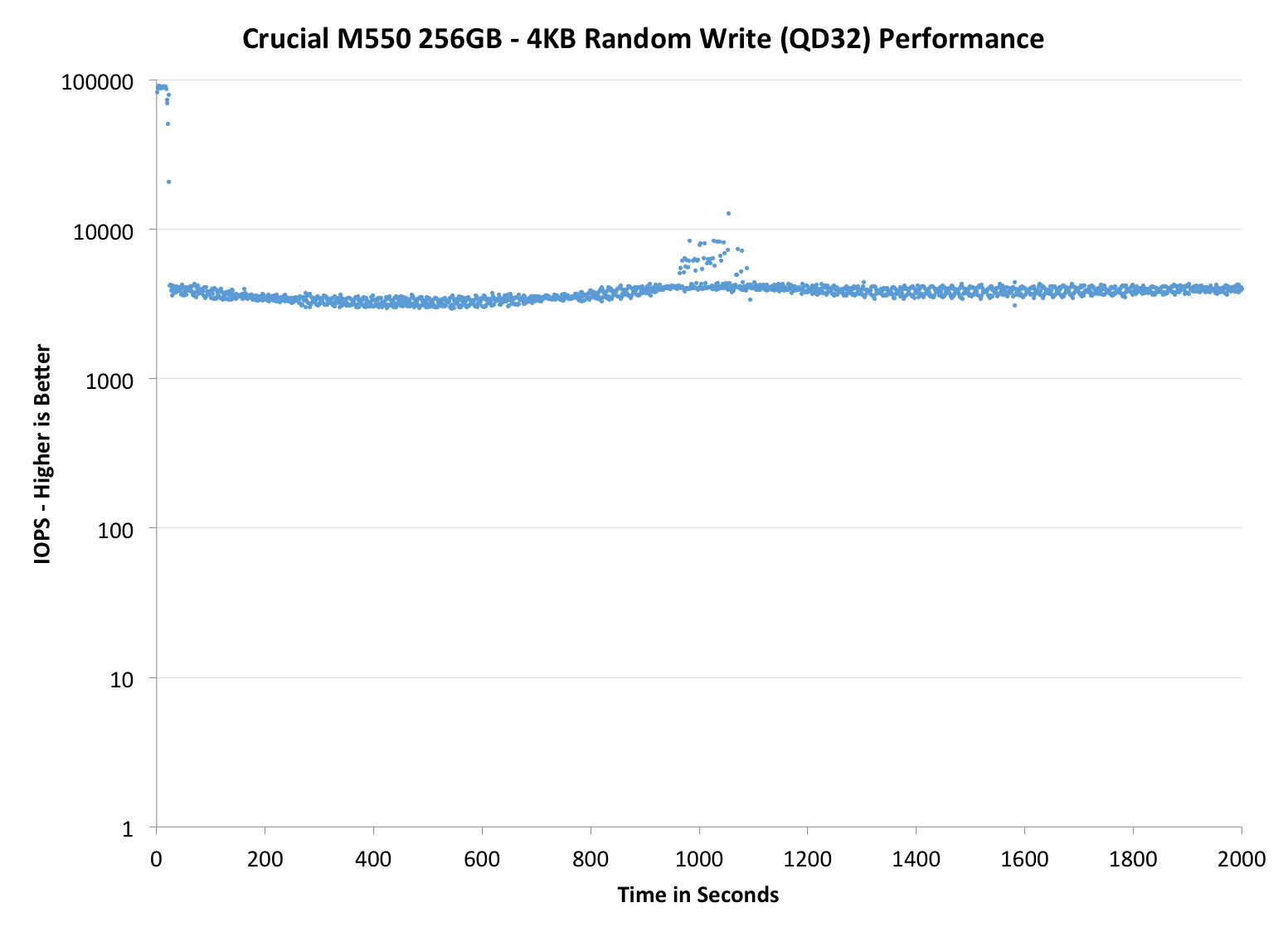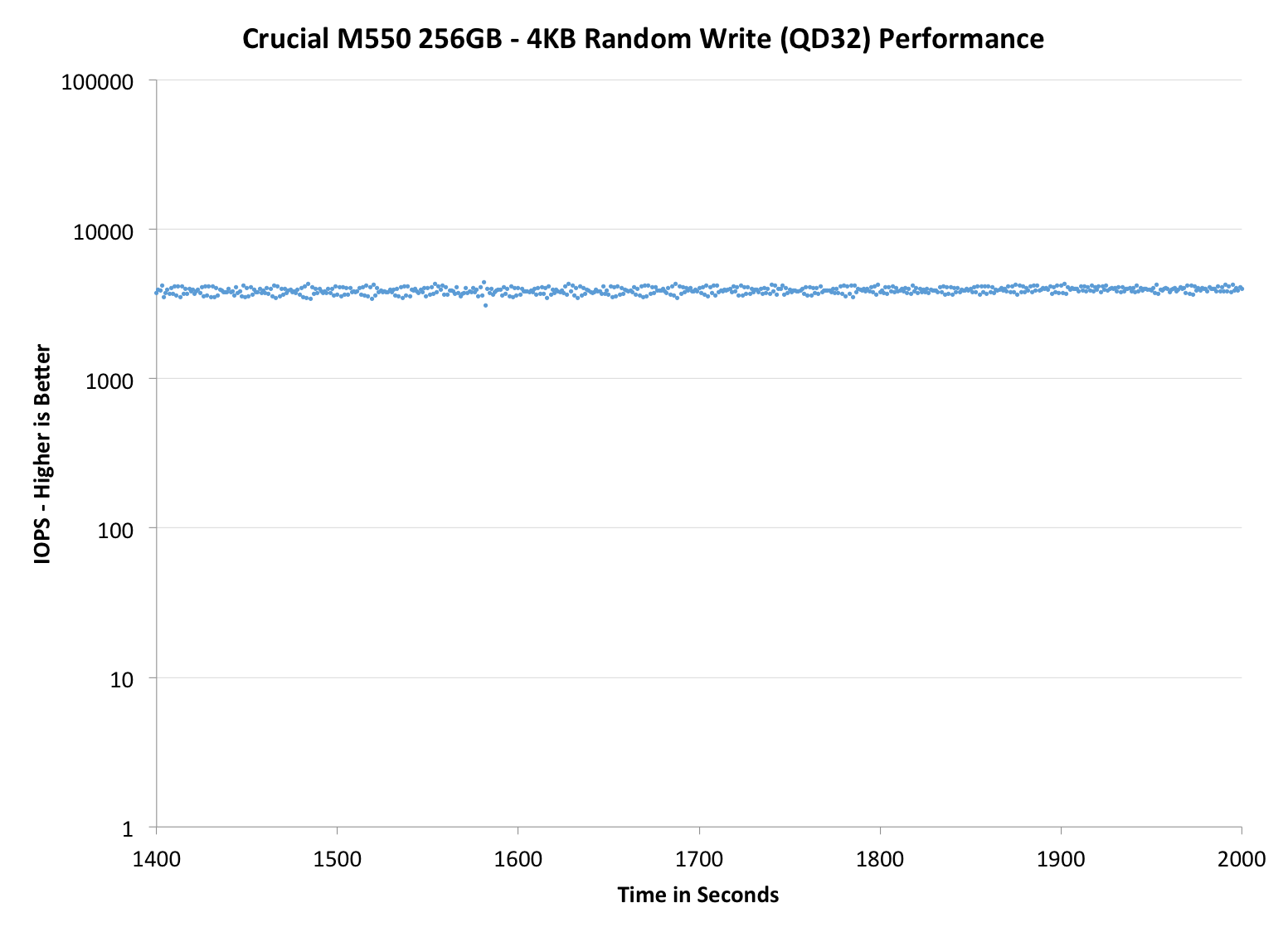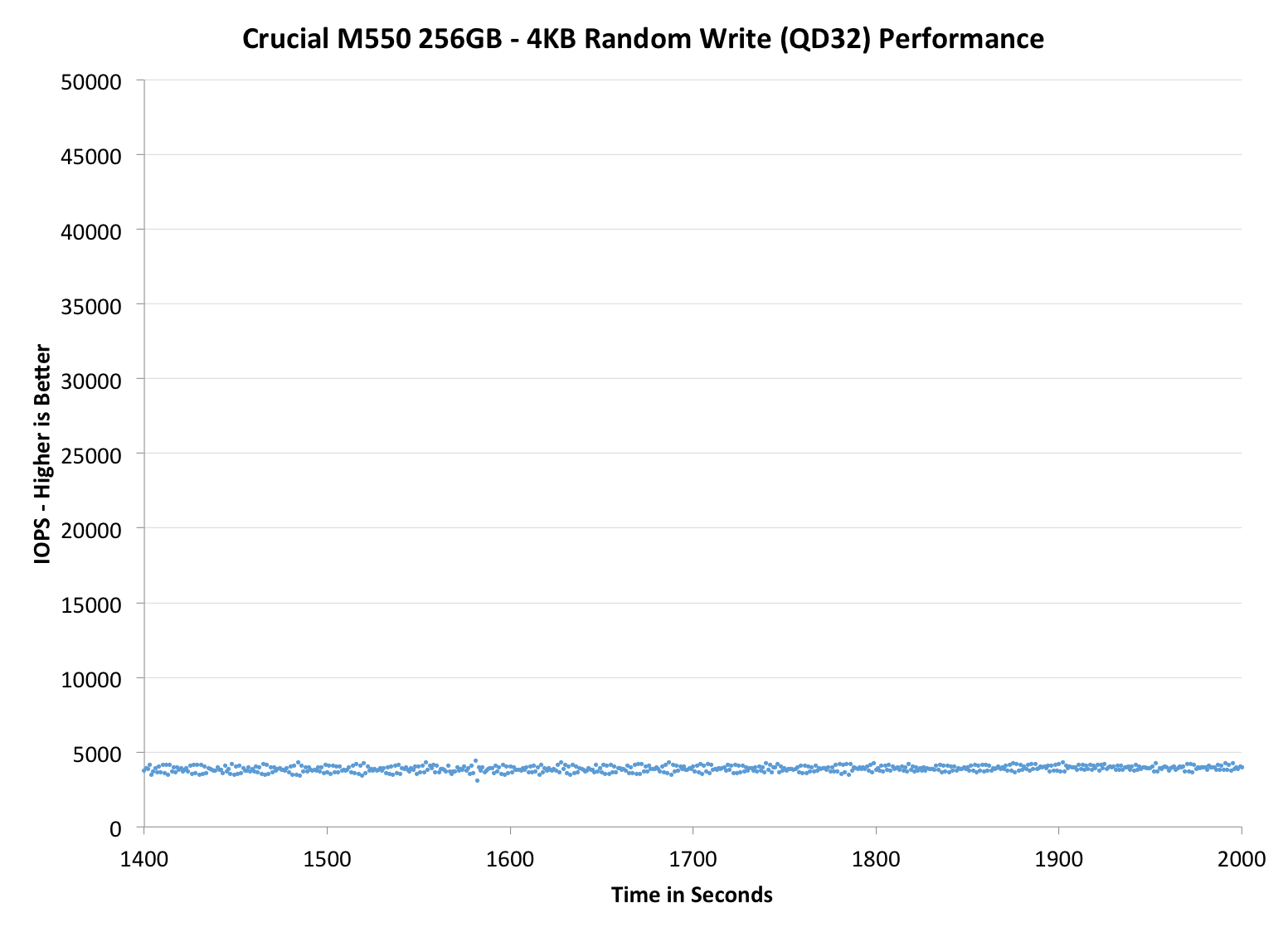Crucial M550 Review: 128GB, 256GB, 512GB and 1TB Models Tested
by Kristian Vättö on March 18, 2014 8:00 AM ESTPerformance Consistency
Performance consistency tells us a lot about the architecture of these SSDs and how they handle internal defragmentation. The reason we don’t have consistent IO latency with SSD is because inevitably all controllers have to do some amount of defragmentation or garbage collection in order to continue operating at high speeds. When and how an SSD decides to run its defrag or cleanup routines directly impacts the user experience as inconsistent performance results in application slowdowns.
To test IO consistency, we fill a secure erased SSD with sequential data to ensure that all user accessible LBAs have data associated with them. Next we kick off a 4KB random write workload across all LBAs at a queue depth of 32 using incompressible data. The test is run for just over half an hour and we record instantaneous IOPS every second.
We are also testing drives with added over-provisioning by limiting the LBA range. This gives us a look into the drive’s behavior with varying levels of empty space, which is frankly a more realistic approach for client workloads.
Each of the three graphs has its own purpose. The first one is of the whole duration of the test in log scale. The second and third one zoom into the beginning of steady-state operation (t=1400s) but on different scales: the second one uses log scale for easy comparison whereas the third one uses linear scale for better visualization of differences between drives. Click the buttons below each graph to switch the source data.
For more detailed description of the test and why performance consistency matters, read our original Intel SSD DC S3700 article.
 |
|||||||||
| Crucial M550 | Crucial M500 | Intel SSD 730 | SanDisk Extreme II | Samsung SSD 840 EVO | |||||
| Default | |||||||||
| 25% Spare Area | - | ||||||||
I can't say I'm very pleased with the IO consistency of the M550. There is a moderate increase (~4K IOPS vs 2.5K in M500) in steady-state performance but other than that there isn't much good to say. All the other higher-end drives run circles around the M550. I should note that the M550 does have considerably less over-provisioning than the other drives but even at 25% OP the results aren't pretty. There is huge variation in performance and the graphs with additional spare area certainly look quite abnormal, but the IOPS is still mostly below 5000. There are peaks of over 50K IOPS too but personally I would prefer a steady line (like the SSD 730) instead of this constant up and down. In client workloads the variation in IOPS isn't as critical as in the enterprise (where predictable performance is a must) but there can be an impact on performance in IO intensive scenarios.
 |
|||||||||
| Crucial M550 | Crucial M500 | Intel SSD 730 | SanDisk Extreme II | Samsung SSD 840 EVO | |||||
| Default | |||||||||
| 25% Spare Area | - | ||||||||
 |
|||||||||
| Crucial M550 | Crucial M500 | Intel SSD 730 | SanDisk Extreme II | Samsung SSD 840 EVO | |||||
| Default | |||||||||
| 25% Spare Area | - | ||||||||
TRIM Validation
To test TRIM, I took a secure erased drive and filled it with sequential data. Then I tortured the drive with 4KB random writes (QD32) for 30 minutes followed by a TRIM command (quick format in Windows). Finally I measured performance with HD Tach to bring you the graph below:
And as you should expect, TRIM works.











100 Comments
View All Comments
Hrel - Wednesday, April 2, 2014 - link
no response? Cause I'd really like this explained. Consistency in these charts stays WAY over 100.shatteredx - Thursday, May 8, 2014 - link
Yeah I'm also confused by the conclusions in this article. The M550 consistency numbers look pretty... consistent!Wolfpup - Monday, March 31, 2014 - link
I can't remember if the M500 has capacitors to deal with power loss or not...suppose I should reread the review. Anyway I choose my 960GB M500 because at the time Intel was using Sandforce controllers, and there's no way I'd use a different brand when Crucial/Micron and Intel are making drives.While there are probably theoretically faster drives than my M500, it's not going to be anything obvious. I can't even really tell that my M500 is any faster than my M4 even though it is on paper.
960GB on a relatively affordable SSD is awesome! Its literally at the point where I'd have had to go with a smaller drive to get a 7200RPM mechanical drive LOL
DKN - Wednesday, April 9, 2014 - link
Latecomer to the discussion. I'm currently running a 240GB M500 drive in an old Lenovo T61p (Core2 Duo T8100). Changing from a 7200RPM HD to the SSD made all the difference in the world as far as day to day use of the laptop.Some things, like logging on are about 5x faster than with the HD. Other things are 10x or more faster, making this old laptop work better than some i7 machines with HDs in the office.
Note that the T61p originally supported SATA 1 and with a BIOS upgrade, it's now SATA 2, so the transfer rates are in line with the capability of the SSD hardware. Purchasing a drive that can support SATA 3 transfer rates wouldn't do anything for the performance of this computer.
The bottom line? While the enthusiast market is lusting for the latest i7 and graphics processor, there is a large market that just needs something better to make their computers work faster.
I'm considering upgrading my two laptops at home with M500 drives. The slower machine with a 240GB and the faster (i7, 2nd Gen) with a 480GB.
Crucial's decision to continue to market the M500 series makes perfect sense for 90% of the users, even if it isn't as fast as the M550.
stevo5800 - Thursday, April 17, 2014 - link
Theres a 60% increase from an M500 and M550 random write but you guys say there is no increase in performance? LOL The average user probably just uses Windows and a few games, so all these drives would perform around the same in the end. Crucial's biggest issue was the lack of higher write speeds. On M500 and earlier write speeds where really low compared to other drives. Plus Crucial also beats some of the other drives in some of the tests here. Almost every SSD manufacturer makes at least 1 decent SSD now a days. Let's not also forget the M550 is brand new and there is still the chance of improvement in some speeds with a new firmware update, we've seen this before. Heck I still find my M4 speedy and it's got way lower specs then the M550. Personally I'm buying a M550 256GB, I'm going for write speeds.AhDah - Thursday, May 15, 2014 - link
Hello all,I want to buy my first SSD
I'm deciding between Crucial M550 1TB and Samsung 840 Evo 1TB
On the Samsung 840 Evo, the TRIM validation graph shows a tremendous performance drop after a few gigs of writes, even after TRIM pass, the write speed is only 150MBps.
Does this mean once the drive is 75%-85% filled up, the write speed will always be slow?
Crucial M550 on the other hand, has a consistent write speed according to the TRIM validation graph.
Should I get the Crucial M550 because of this?
thanks!
critter13 - Thursday, May 15, 2014 - link
I have a 2007 MBP which is obviously SATA II. Is it worth getting a m550 or 840 EVO or will I not see the extra speed? should I save a little money and just go with the m500?SyndromeOCZ - Friday, May 30, 2014 - link
Seriously why do you make the title of the article a link? Ok if it was a link that actually went anywhere but a link that goes directly to the page I'm viewing. Doing this makes it about 1000 times harder to copy paste parts out of the title, forcing me to have to go through the article to find the part I want to copy. Which in turn forces me to want to never come back to Anandtech again. Just my $0.02ayejay_nz - Sunday, February 15, 2015 - link
Any word on whether the MU02 firmware update, released 01/8/2015, for this drive boosted performance?The release notes can be found here - http://www.crucial.com/wcsstore/CrucialSAS/firmwar...
I'm not sure if the items they've listed as improving would increase performance?
pokazene_maslo - Tuesday, October 3, 2017 - link
In changelog they mentioned improved power efficiency. Could anyone test power consumption in idle after FW upgrade?